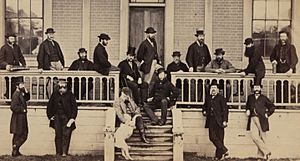Legislative Council of British Columbia facts for kids
Quick facts for kids Legislative Council of the United Colony of British Columbia |
|
|---|---|
| Type | |
| Type |
unicameral house of the Governor-in-Council of the United Colony of British Columbia
|
| History | |
| Founded | 1867 |
| Disbanded | 1871 |
| Preceded by | Legislative Assembly of Vancouver Island Colonial Assembly of British Columbia |
| Succeeded by | Legislative Assembly of British Columbia |
| Meeting place | |
| Legislative Hall | |
The Legislative Council of British Columbia was a special group of advisors. It was created in 1867 to help the governor of the new Colony of British Columbia. This new colony was formed when the old Colony of Vancouver Island and the Colony of British Columbia (the mainland) joined together.
Even though the council discussed important matters, the governor still made the final decisions. This meant the colony did not have "responsible government." At the time the council started, Frederick Seymour was the governor. The council was active until 1871, when British Columbia became a province of Canada.
Who Were the Members?
The Legislative Council had three main types of members. Each group played a different role in advising the governor.
Senior Officials
Five members were senior officials of the colony. These people also formed the governor's executive council. They were important government leaders.
- Arthur N. Birch – Colonial Secretary (like a chief administrator)
- H.P.P. Crease – Attorney-General (the colony's chief lawyer)
- W.A.G. Young – Acting Treasurer (managed the colony's money)
- Joseph W. Trutch – Chief Commissioner of Lands and Works (in charge of land and building projects)
- Wymond Ogilvy Hamley – Collector of Customs (collected taxes on goods)
Magistrates
Nine members were magistrates. Magistrates were like local judges or officials. Some of these magistrates were chosen because they were popular in their areas. This helped make the council seem more fair and democratic.
- Thomas L. Wood – Acting Solicitor-General (another senior lawyer)
- Henry Maynard Ball – Magistrate, Cariboo West
- Chartres Brew – Magistrate, New Westminster
- C.F. Cornwall – Magistrate, Thompson River District
- W.G. Cox – Magistrate, Cariboo East
- W.J. Macdonald – Magistrate, Victoria
- C.S. Nicol – Magistrate, Nanaimo
- Peter O'Reilly – Magistrate, Kootenay
- E.H. Sanders – Magistrate, Yale and Lytton
Elected Members
Nine members were chosen by the people through elections. However, even though they were elected, the governor still officially appointed them. This was done to respect the wishes of the people.
- Amor de Cosmos – Victoria
- J.S. Helmcken – Victoria
- Joseph D. Pemberton – Victoria
- John Robson – New Westminster
- R.T. Smith – Columbia River and Kootenay
- J.J. Southgate – Nanaimo
- Edward Stamp – Lillooet
- G.A. Walkem – Cariboo
- George Wallace – Yale and Lytton
One elected member, George Wallace, resigned his seat early. A special election was held, and F.J. Barnard took his place.
End of the Council
The Legislative Council was dissolved in 1871. This happened when British Columbia joined Canada and became a province. A new government structure was then put in place for the province.


